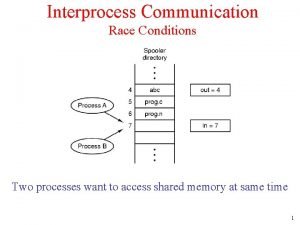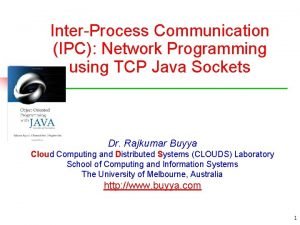UNIX Interprocess Communication Interprocess Communication The pipe is







- Slides: 7

UNIX Interprocess Communication

Interprocess Communication � The pipe is the IPC mechanism most characteristic of UNIX � Permits a reliable unidirectional byte stream between two processes � A benefit of pipes small size is that pipe data are seldom written to disk; they usually are kept in memory by the normal block buffer cache � In 4. 3 BSD, pipes are implemented as a special case of the socket mechanism which provides a general interface not only to facilities such as pipes, which are local to one machine, but also to networking facilities. � The socket mechanism can be used by unrelated processes.

Sockets � A socket is an endpont of communication. � An in-use socket it usually bound with an address; the nature of the address depends on the communication domain of the socket. � A characteristic property of a domain is that processes communication in the same domain use the same address format. � A single socket can communicate in only one domain — the three domains currently implemented in 4. 3 BSD are: � the UNIX domain (AF_UNIX) � the Internet domain (AF_INET) � the XEROX Network Service (NS) domain (AF_NS)

Socket Types � Stream sockets provide reliable, duplex, sequenced data streams. Supported in Internet domain by the TCP protocol. In UNIX domain, pipes are implemented as a pair of communicating stream sockets. � Sequenced packet sockets provide similar data streams, except that record boundaries are provided � Used in XEROX AF_NS protocol � Datagram sockets transfer messages of variable size in either direction. Supported in Internet domain by UDP protocol. � Reliably delivered message sockets transfer messages that are guaranteed to arrive (Currently unsupported). � Raw sockets allow direct access by processes to the protocols that support the other socket types; e. g. , in the Internet domain, it is possible to reach TCP, IP beneath that, or a deeper Ethernet protocol � Useful for developing new protocols

Socket System Calls � The socket call creates a socket; takes as arguments specifications of the communication domain, socket type, and protocol to be used and returns a small integer called a socket descriptor. � A name is bound to a socket by the bind system call. � The connect system call is used to initiate a connection. � A server process uses socket to create a socket and bind to bind the well-known address of its service to that socket � Uses listen to tell the kernel that it is ready to accept connections from clients � Uses accept to accept individual connections � Uses fork to produce a new process after the accept to service the client while the original server process continues to listen for more connections

Socket System Calls (Cont. ) � The simplest way to terminate a connection and to destroy the associated socket is to use the close system call on its socket descriptor. � The select system call can be used to multiplex data transfers on several file descriptors and /or socket descriptors.

References � “Operating System Concepts, " by Abraham Silberschatz, et al, 9 th Edition, 2012, John Wiley & Sons Inc. � Operating Systems: A Spiral Approach 1 st Edition by Ramez Elmasri , A Carrick , David Levine












